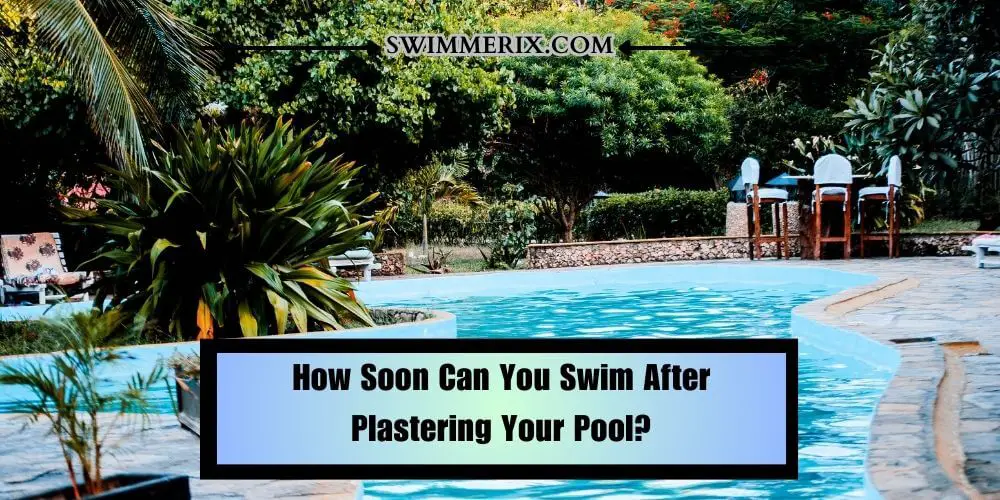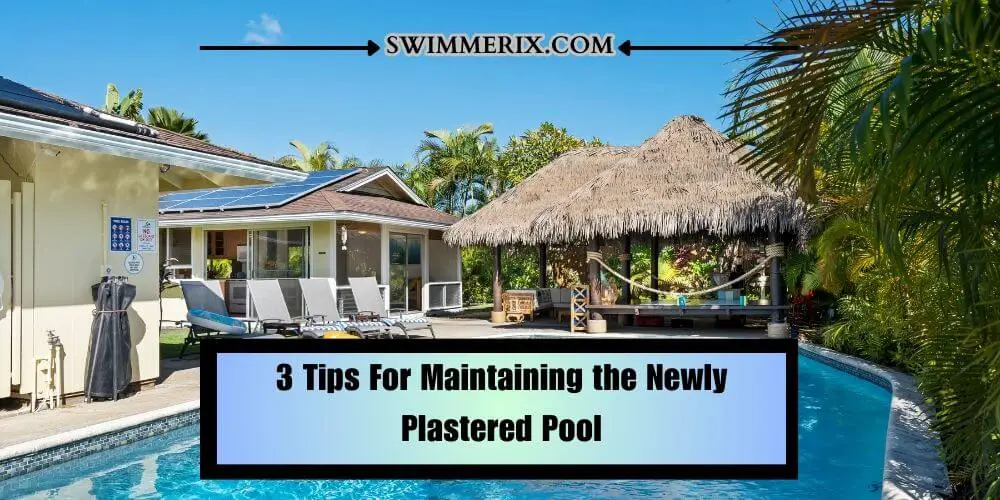
If you have just got your pool plastered and are eagerly waiting to take a refreshing dip, you might wonder, ‘How soon can you swim after plastering your pool.’ In this comprehensive guide, I will tell you ‘how soon you can swim after plastering your pool’ and how soon it is too soon.
We will be delving into the details & providing you with some necessary information to ensure your pool is ready for swimming & safe experience. There are also many different types of pool plasters available & the curing time will depend upon the plaster used.
On average, it takes about seven days to 10 days for the plaster to cure. But before I tell you the factor influencing the waiting period, let’s first find out ‘how long you can swim after plasters your pool.’
How Soon Can You Swim After Plastering Your Pool?

After plastering a pool, it is important to allow the plaster to cure properly before allowing swimmers into the pool. The curing process helps the plaster to set & harden, ensuring its durability and longevity.
The time required for the plaster to cure can vary depending on several factors, including the type of plaster used & the weather conditions. Pool plastering employs applying a layer of plaster to the pool surface, providing a smooth & waterproof finish.
This process enhances your pool’s appearance and protects it from damage while extending its lifespan. Since there are different types of pool plaster available, like white plaster, colored plaster, and pebble finishes, each has its unique characteristics & aesthetics.
White plaster, one of the most common choices, provides a classic & clean look, whereas colored plasters allow you to add a personal touch to your pool with various color options. Pebble finished offering a texture & natural appearance, adding an extra dimension to your poor design.
You will have to wait approximately ten days for the plaster to cure. Also, it is important to note that the time frame of plaster curing may vary depending upon several factors, including weather conditions & proper maintenance. To give you a better understanding of the waiting periods associated with different types of pool plaster, let’s take a look at the following table:
Type of Pool Plaster & Their Recommended Curing Time
| Type of Pool Plaster | Recommended Curing Time |
| White Plaster | 7-10 days |
| Colored Plaster | 10-14 days |
| Pebble Finish | 14-21 days |
Please know that these are only general guidelines & specific recommendations from the plaster manufacturer which you should follow. It is also important to consider the curing time as a minimum requirement and allow some additional time for the plaster to set & Harden fully.
When you are in the waiting period, make sure to monitor the curing process by observing the plaster color. Initially, the plaster will appear darker, but over time, it must lighten or reach its intended shade.
In addition to this, you should also perform a water balance test to ensure the chemical levels are properly adjusted. When you are filling up the pool, swimming in it will also be affected, depending upon the measurement of PH, alkalinity, chlorination & calcium hardness level in the water. To know more about this, check out my other article, “How Soon Can You Swim in a Newly Filled Pool.“
Therefore, make necessary adjustments to maintain optimal water conditions for curing. To gain more valuable insights & in-depth information on swimming in a newly painted pool, consider reading my recent articles on
‘How long can you swim in a newly filled pool.’ Now it’s time to pay attention to the factors that may influence the waiting period for a safe & enjoyable swimming experience in a newly plaster swimming pool.
3 Factors Influencing the Waiting Period
Temperature
The temperature affects not only the water chemical stability of water quantity in the pool but also the curing time of plaster. During my research, warmer temperatures facilitate faster curing, whereas colder temperatures slow the process. The ideal temperature that encourages proper curing is around 70-80 degrees Fahrenheit.
Humidity
Another factor that plays a crucial role in the curing process is humidity. You should know that the higher humidity usually extends the curing time, so consider this factor when determining when to swim.
In addition to this, it is important that you also maintain perfect chemical balance in the water. If you don’t pay attention to the water chemistry, you will likely face waterborne diseases, including eye irritation. Therefore, you should monitor water chemistry and adjust to promote proper plaster curing.
Other Factors
Other factors that may influence the waiting period of when to swim after plastering a pool depend upon the type & quality of plasters being used, the pool size, and the presence of any addiction.
First, I recommend you check the water parameters using a water testing kit & consult with a pool professional who can provide specific guidance on these factors.
3 Steps To Prepare the Pool for Swimming
Professional will help provide you with the recommended waiting period. Once the waiting period has passed, you must prepare your pool for a safe & enjoyable swimming experience.
Remember, taking the time to properly prepare the pool for swimming after plastering ensures that you have a clean & enjoyable swimming experience while protecting the newly plastered surface. Below are some valuable tips.
- Filling The Pool: Before you dive into your newly plaster pool, it is important that you fill it with fresh water & maintain its level to avoid any stress on the plaster surface.
- Water Chemistry: After filling up the pool, you need to test the water PH, alkalinity, & calcium hardness level, as proper water parameters are important to maintain the integrity of the plasters. Also, adjust parameters as necessary to maintain a balance & save the swimming environment or consult with a pool professional to ensure accuracy. It is important that you also use reliable testing kits.
- Chemical Balancing: Apart from water chemistry like PH, alkalinity, & calcium hardness, there are also a few chemical factors like chlorination & sanitizer levels which must be properly balanced for a safe swimming journey. These chemicals are important in maintaining water cleanliness and preventing the growth of bacteria & algae.
3 Tips For Maintaining the Newly Plastered Pool

Once the newly plastid pool is ready to dive into, you can enjoy a safe swimming experience. However, consider the longevity of the plaster & keep it in top condition by following some maintenance tips as well.
Skimming & Cleaning
First, clean your pool by routinely skimming the surface and removing debris. You should also consider vacuuming the pool floor, but if you find it hard to open the vacuum port, here is the in-depth article on ‘How to Open the Pool Vacuum Port.’ Make sure to perform regular maintenance to prevent dirt & particles from accumulating on the plaster surface, minimizing the risk of stains & discoloration.
Brushing
There is nothing wrong with brushing off the pool wall & floor required, especially after plastering. I often use a pool brush with soft bristles to gently scrub the plaster surface to help remove any loose material.
This further also promotes a smooth and even finish. Apart from brushing the pool walls & floor, you need to regularly test the water chemistry to ensure it remains properly balanced. Thereby, monitor the pH, alkalinity, and sanitizer level to make necessary adjustments. Not giving attention to pool maintenance may result in Tiny Bubbles on Pool Wall.
Chemical Balance & Inspection
A proper chemical balance not only protects your plastering but also ensures a safe & healthy environment for swimming. Also, make sure to schedule routine inspections with a pool professor to identify any potential issue early on in the pool & assess the conditions of the plaster.
Experts are great at advising on maintenance & repairs while identifying signs of damage. Therefore, follow all these guidelines to ensure a safe & swimming experience while prolonging the life of your pool plaster.
Related Topic: How Long Can You Leave a Pool Unattended
Conclusion
It is important you understand when it is safe to swim after plastering your pool for the longevity & performance of both the plaster & the pool. I have given my best to give you in-depth knowledge on the question, ‘How soon can you swim after plastering your pool.’
If you are eagerly waiting to dive into your newly plastered pool, consider the type of plaster, weather conditions, and the waiting period to ensure your pool is ready for swimming. Also, pay attention to the proper water chemistry balance and follow a regular maintenance routine to keep your newly plastered pool pristine.
Once your pool plaster has fully cured, you can take the lunge & enjoy your revitalized swimming Oasis. I hope you know how soon you can swim after plastic in your pool. If you have any other concerns regarding the question ‘How soon can you swim after plastering your pool,’ drop a comment below.
So check my other helpful guide on pool care & maintenance to enhance your swimming experience and ensure safety. See you in the next post, till then, take care & goodbye.

